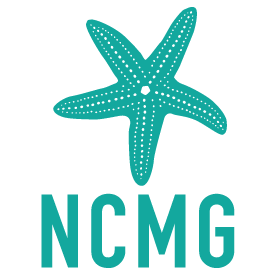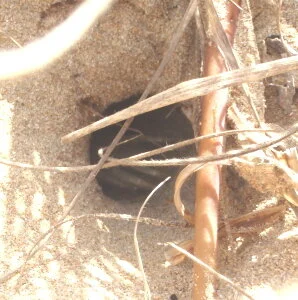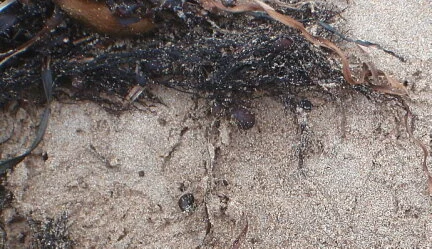BATEMANS MARINE PARK’S BEACHES - COMMON PLANTS & ANIMALS
The Batemans Marine Park has many beaches. Nearly all of them differ from one another depending on such things as their exposure to ocean waves, the nature of the sand and whether they are near river mouths. These factors have a big influence on the type of plants and animals that live there.
Bengello Beach near Moruya airport (right) Is a high energy system. It experiences heavy surf especially during ocean storms and its dunes have regularly been eroded. These have built up again as summer north east winds blow sand up the shore. The beach and the ancient dunes behind it have been extensively studied by Professor Bruce Thom and colleagues researching coastal management and the possible impacts of sea level rise.
From Canberra Grammar excursion booklet
Beaches around Batemans Bay are low energy.
Waves are usually smaller but sand moves in currents around the Bay, building up on sand banks and some shores while eroding others such as at Cullendulla. (pictured below).
The sand itself also varies in size of the grains and in their composition. High energy beaches have coarser sand while sand is finer where waves have less energy.
The composition of sands of the beaches from Malua to North Broulee were analysed and found to have high carbonate content from ground up shells. Shelly Beach on Broulee Island is almost pure shell grit. Bengello Beach to the south of Broulee Island is mainly quartz and has very little carbonate. Nearer Moruya River the sand changes again with a higher content of other minerals carried down by the river in rock particles eroded from the catchment.
As beaches differ so do the plants and animals that exist there. While the plants are easily seen most of the marine animals live buried beneath the sand, mostly at or below the low tide mark.
PLANTS NEAREST THE BEACH
Dune plants trap wind-blown sand and speed up the rebuilding of the foredune after erosion. There is a zonation of plants from the foredune to the more sheltered back dunes.
Three plants that are likely to be growing nearest the high tide mark on high energy beaches are:
Spinifex
Spinifex sericeus
European Sea Rocket
Cakile maritima
Sea Spurge
Euphorbia paralias
Spinifex
A perennial native grass with runners and silver-green strap like leaves. Flowers appear in late spring. Seeds form in a spiky ball that detaches and rolls along the beach.
European Sea Rocket
A spreading succulent thought to have arrived in ship’s ballast in the early 1900s. It is now common on Eurobodalla’s beaches near the high tide line but is not a problem.
Sea spurge
This cane toad of the dunes with noxious milky sap was introduced about 60 years ago and spreads rapidly. The sap can irritate the skin and damage the eyes. Please notify Council if you see any so it can be controlled.
Some information about plants near low energy beaches can be found in the article on Estuaries.
BIRDS
Migratory Shore Birds
In summer several species of threatened migratory shore birds nest high on the beach.Their nests are very vulnerable and volunteers try to help by erecting signage or temporary fences.You can help by staying well away and keeping your dog on a leash on beaches with the nesting sites.
Hooded Plover nest, Durras, Photo by John Perkins
Pied Oystercatcher, Photo by Jane Elek
Two threatened shore birds that are permanent residents are the black and white Pied Oystercatcher (right) -which nests near the high tide mark- and the Sooty Oystercatcher – more often seen on rocky shores.
CRABS AND OTHER CRUSTACEANS
Smooth-handed Ghost Crab
Grow to 35 mm across the back. These small fast moving sand coloured crabs live in deep holes in the dunes far above high tide. They come out at night to scavenge on the beach near the water.
Smooth-handed Ghost Crab Ocypode cordimanus
Photos by Jennifer Wilcox
Sand Hoppers or Beach Fleas Grammarid amphipods
These tiny crustaceans bury in the sand near the strand line and feed on rotting seaweed and the decaying remains of fish and birds.
The grid squares are 5 x 5mm
Some of the amphipod holes are visible in the sand
Surf Crab Ovalipes australiensis
Surf Crab
Grow to 10 cm across the back
It is a swimming crab with flattened “paddles” on its hind legs. It moves easily in the water and can quickly dig in backwards to bury itself in the sand. The two spots on its back make it easy to identify. This crab is expert at stealing the bait of beach fishers.












